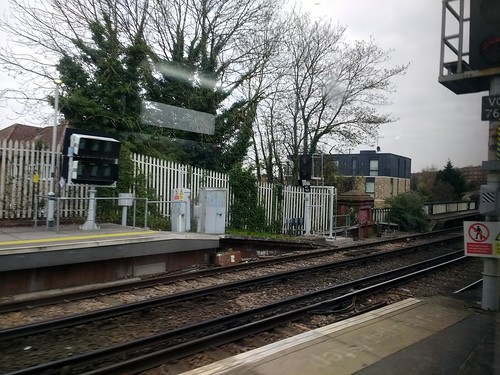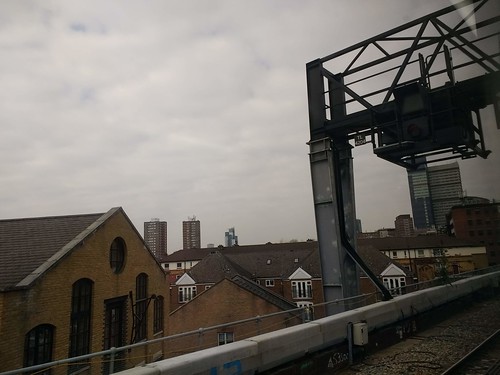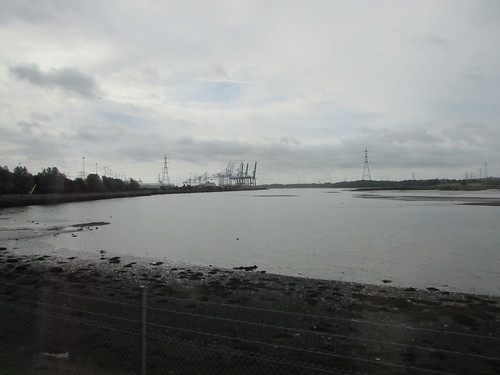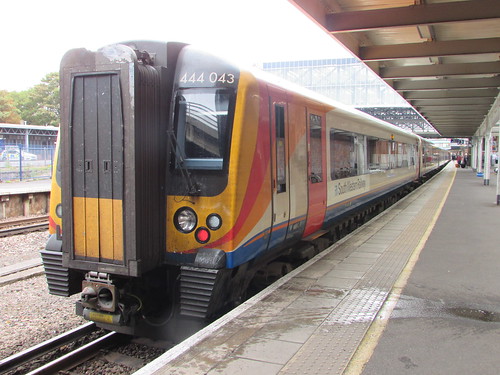| Wolverhampton-Bath | Arrive | Depart |
| Wolverhampton | 06:04 | |
| Sandwell and Dudley | 06:14 | 06:14 |
| Birmingham | 06:24 | 06:42 |
| Cheltenham | 07:20 | 07:23 |
| Bristol Parkway | 07:53½ | 07:55 |
| Bristol Temple Meads | 08:05 | 08:23 |
| Bath Spa | 08:35 |
After a taxi from my home to Wolverhampton station, a Virgin Trains 'Pendolino' whisked me to Birmingham in reasonable comfort. But, using the escalators at the south end of the platform which are signed as giving access to other platforms, I knew that finding my departure platform would actually be confusing. I had to exit through the gate line near the main exit, walk through the dreadful 'Grand Central' shopping centre and re-enter the station through a different gate line before I could hunt for my train. When I reached platform 11B my train, a Cross Country 'Voyager' was present but shut-down, so all the passengers were glumly waiting on the platform. A few minutes before departure, the driver must have arrived because the train's diesel engines burst into life and after a short wait the doors were enabled, finally allowing the waiting passengers to board. My train, the 06:42 from Birmingham New Street to Painton, reporting number 1V41, set off on time on the former Midland Railway route via Five Ways.
When I was younger and carriage windows could be opened I would often follow progress by sighting each signal as we approached and often making copious (if illegible) notes on the track and signalling layout. A modern equivalent is to follow the route using a 'Smartphone' and the remarkable facilities of Railcam.UK which I outlined in the post Watching The Trains Go By. In the New Street display on Railcam UK, train describer 'berths' showed the position and reporting numbers of all trains but, once we passed Five Ways, signal aspects appeared on the diagram as well. As displayed in signalling centres, these are simply shown as 'red' or 'green' whereas the driver will also be presented with 'yellow', 'double yellow' or, sometimes, flashing aspects by the actual signals themselves. Older signalling systems, like New Street, only provide train describer information to Network Rail's external database but more modern systems supply signal data as well. The Network Rail database is interrogated by Railcam UK to provide the remarkable ability to track progress from within the train itself.
We made good progress 'under the wires' through the extended Bromsgrove station where electrification finishes and I noticed on the Railcam UK diagram train 2O70 ahead of us. Railcam UK confirmed that this was a Worcester to Bristol diesel multiple unit so it had joined our route at Abbotswood Junction. I wondered whether we would be 'baulked' by this slower train but, in fact, we arrived at Cheltenham about one minute early. This was just as well as the train filled right up with commuters heading to Bristol, using up all our station allowance. We left Cheltenham as booked, by which time I'd realised that, after its departure from Cheltenham, the DMU would leave our route at Barnwood Junction to call at Gloucester, where it would reverse and only rejoin our route well after my train had passed.
At Standish Junction the line to Swindon peeled off to our left then I noted Wickwar Tunnel, Yate station and soon we were slowing for the long right hand curve as we joined the Great Western Main Line at Westerleigh Junction, now 'under the wires'. We arrived three minutes early for our booked stop at Bristol Parkway. Despite at the improvements and extensions to the facilities here, the place still strikes me as having a rather 'temporary' appearance.
I believe electric trains now operate as far as Bristol Parkway on the Great Western Main Line. Although the line towards Wales Has been equipped with Overhead Line Equipment at least as far as Severn Tunnel Junction, services are no yet electric. There's no obvious work been carried out on the line from Bristol Parkway to Bristol Temple Meads and the route through Filton Abbey Wood, Stapleton Road and Lawrence Hill is still unsullied by 'knitting'. However, the Relief lines which were removed some years ago have been reinstated.
We arrived at Bristol Temple Meads on time, stopping in platform 3/4 under the airy, curved trainshed. Brunel's original terminal station featured a straight trainshed which is no longer part of the operational railway. The Bristol and Exeter Railway trains reached Brunel's terminal by an inconvenient, curved approach with its own platform. In the 1870s this area was developed with the impressive curved trainshed which survives and further platforms were added in the 1930s, more modestly provided with umbrella roofing.

Trainshed over the through lines at Bristol Temple Meads viewed from platform 3/4, looking west.
I'd not expected to see a Class 43 HST at Bristol Temple Meads since the advent of the Class 800 bi-mode trainsets had replaced them on the Paddington route, but there was an HST, in First Great Western livery, in platform 5/6. Railcam UK informed me that it was an empty stock working from Bristol St. Philips Marsh Depot to Hull by the Rail Operations Group, reporting number 5E23. I made my way through the wide underground passage linking the various platforms to wait for my service to Bath from platform 9. Whilst waiting, I took a few pictures.

Bristol Temple Meads, View from east end platform 9: Empty stock HST on far left and Colas Rail Test Train in High Level Siding.

Bristol Temple Meads Station: View looking west from platform 11.

Bristol Temple Meads Station: View looking east from platform 11, with Class 800 arriving in platform 13.
The Great Western Railway Railway Diesel Multiple Unit heading for Salisbury arrived on time and quite a crowd boarded. It took just twelve minutes to reach Bath Spa station, where many of the passengers alighted.

Bath Spa: View from Platform 2 looking towards London.
I made my way through the pedestrian passage to the south side where I was met at the small pick up/drop off area.

Bath Spa: Station buildings on Down side, viewed from passenger Drop-off Point, showing restored canopy.
After my meeting, I was pretty tired. I purchased a e-ticket for my journey back to Wolverhampton using an 'app' on my mobile phone during the car trip to Bath Spa station. This stored two versions of the ticket on my phone - a human-readable version and a machine-readable 'QR' code there's a useful article of 'QR' codes in Wikipedia here). Ticket inspectors on trains either check the details on the human-readable version or, sometimes, have a portable scanner which 'reads' the 'QR' code. But most of the ticket gates that have proliferated can't read e-tickets so a member of staff has to peer at the screen on your mobile and then let you through. But, to my surprise, the modern barrier at Bath was equipped with a small horizontal glass screen (like a miniature supermarket product scanner) so the computer in my smartphone talked to the computer in the ticket gate and I was admitted to the platform.
The return timings were:-
| Bath-Wolverhampton | Arrive | Depart |
| Bath Spa | 16:28 | |
| Bristol Temple Meads | 16:40 | 17:30 |
| Bristol Parkway | 17:38 | 17:40 |
| Cheltenham | 18:08½ | 18:16 |
| Birmingham | 18:56 | |
| Wolverhampton |
The first 'leg' was on the three o'clock Down from Paddington, reporting number 1C19. This was my first trip on a Class 800 'Bi-Mode' (here running on diesel-power since electrification of the line through Bath to Bristol is yet to happen). The train was, as expected, busy but I found a seat. I rated the experience as 'OK' but not particularly impressive. But it was only a short journey and I was tired - perhaps I'll enjoy my next trip on the Hitachi-built trains more.
Of course, Bristol Temple Meads was packed so I made my way across to platform 3 to await the arrival of the 15:25 from Plymouth (with a lot of other passengers). The train was due in at 17:22½, leaving at 17:30. To my delight, a refubished Cross-Country 'HS125' was working the service. From Railcam UK I confirmed that the train was scheduled into Birmingham at 18:56, leaving at 19:03 for Leeds where it was due to arrive at 21:02. The reporting number was 1E63. The train was heavily loaded but I managed to get a seat at Bristol and we were soon making our first stop at Bristol Parkway.

Bristol Parkway station.
Just over five miles beyond Bristol Parkway, at Westerleigh Junction, we passed over the single line branch which I believes serves Westerleigh Oil Terminal then the line to Cheltenham curves sharply away from the Great Western route to Paddington, with an overlap 'under the wires' on the Cheltenham line.

Bristol area rail: The line to Cheltenham curves away from the Great Western Main Line at Westerleigh Junction, with an overlap 'under the wires'.
Just before Yate station, the single line we'd crossed over converged with the Cheltenham line on our left. Railcam UK showed a DB Freight from Westerleigh Oil Terminal to Robeston (near Milford Haven), reporting number 6B47, on the branch.
At Cheltenham Spa, a lot of passengers left the train, but quite a few also joined. We then continued, without incident, to Birmingham New Street where many passengers, including me, disembarked but the platform was crowded with passengers waiting to join the train.
I quickly located the platform for the next Wolverhampton departure (a West Midland Trains service to Shrewsbury, I think) and I found a seat just before it left
Related Posts on other Websites
Bristol Temple Meads railway station (Wikipedia).
Book References
[1] 'Regional History of the Railways of Great Britain: Vol. 11, Thames and Severn' by Rex Christiansen (ISBN: 0715380044)
My pictures
Where necessary, clicking on an image above will display an 'uncropped' view or, alternately, pictures may be selected, viewed or downloaded, in various sizes, from the album below. Apologies for the poor quality of pictures taken from trains.
Bristol area railways.



























